With an unlimited number of internal and external factors impacting the operations of every organization, a potential crisis is never too far around the corner.
And, while we can rarely predict a crisis, we can certainly prepare for it.
In this article, we will examine the anatomy of a comprehensive crisis communication plan. We’ll also provide 11 ready-made, industry-specific crisis communication plan templates to help you better prepare for any eventuality.
Quick access to crisis communication plan templates:
⏬ General crisis communication plan template
⏬ School crisis communication plan template
⏬ University crisis communication plan template
⏬ Business crisis communication plan template
⏬ Technology crisis communication plan template
⏬ Hospitality industry crisis communication plan template
⏬ Non-profit crisis communication plan template
⏬ Hospital crisis communication plan template
⏬ Sports crisis communication plan template
⏬ Transport & logistics crisis communication plan template
⏬ Agriculture crisis communication plan template

What is crisis communication?
Crises represent unpredictable events perceived to:
- Threaten an organization’s performance,
- Jeopardize stakeholder expectations, and
- Create negative outcomes.
According to one definition, crisis communication is “The process of creating and exchanging messages between interdependent stakeholders in conditions of high uncertainty, threats to high-priority goals, and the need for immediate response created by a crisis.”
In other words, crisis communication includes all the messages an organization broadcasts in response to a crisis.
Crisis communication can take place internally, within the organization, and externally, towards different groups of stakeholders and the general public.
Both internal and external crisis communication are equally important, because:
- Internal communication can enable and motivate employees and other members of an organization to perform through times of crisis, and
- External communication protects the reputation of the organization in the eyes of its stakeholders and the public.
🎓 Pumble Pro Tip
If you’d like to learn about the guiding principles of effective internal crisis communication, read our guide:
What is a crisis communication plan?
A crisis communication plan is a set of guidelines, information, and resources that represent a blueprint for a fast and effective response to an emerging crisis.
Also known as a crisis management plan, it includes communication steps and operational processes that span the duration of a crisis, from identifying what’s taking place all the way to post-crisis assessment.
It gathers all relevant information in one place and helps organizations formulate and communicate a cohesive and consistent set of messages that will help overcome a crisis — or at least not make a bad situation even worse.
How to make a crisis communication plan?
Crisis communication plans come in many shapes and sizes. They can be bare-bones or extremely detailed and can include or exclude certain sets of information.
Regardless of their format or scope, any comprehensive crisis communication plan should be devised with the following steps in mind:
- Define the alert mechanisms,
- Define the goal,
- Define team roles and personnel,
- Identify key stakeholders,
- Conduct risk assessment and potential escalation,
- Define employee guidelines,
- Gather the necessary information,
- Plan information distribution, and
- Conduct a post-crisis evaluation.
Let’s see what these steps represent and how each of them contributes to a successful crisis communication strategy.
Step #1: Define the alert mechanisms
This step refers to the internal activities at the first notice of an emerging crisis.
Specifically, this area defines what takes place once a crisis is detected:
- Who needs to get notified,
- What mechanisms are triggered, and
- What the necessary steps are to get the response team up and running as quickly as possible.
This step can easily be considered as step 0 — the one any organization should implement before a crisis even occurs.
Planning alert mechanisms can be a difficult challenge, especially when you need to get numerous parties notified swiftly.
However, having alert mechanisms ready before a crisis strikes can give you an undeniable advantage and, in many cases, prevent further escalation.
Including your most important stakeholders in a dedicated communication app allows for a swift initial reaction, especially when time is of the essence.
Need a business communication app? Try Pumble
Step #2: Define the goal
In the context of a crisis communication plan, defining the goal isn’t a vague, abstract mission statement, but a very practical definition of the document’s scope.
Defining the goal includes defining your communication plan’s purpose and its communication objectives.
For instance, the plan can be intended solely for internal crisis communication, exclusively for the media, the general public, specific groups of stakeholders, or all of the above.
Ask yourself — what is the main thing we must achieve, and the one thing we need to avoid?
Understanding the scope, the purpose, and the objectives of crisis communication will enable you to devise the right approach.
Step #3: Define team roles and personnel
Having a dedicated crisis response team with clearly defined roles and responsibilities is a prerequisite to effective crisis management.
A crisis response team is supposed to organize and coordinate a variety of tasks related to 4 main areas of activities:
- Gathering information,
- Decision making,
- Formulating messages, and
- Communicating messages.
The make-up of a response team will be determined by the specifics of an organization’s work.
However, the general distribution of key roles remains fairly universal, including:
- Designated internal and external spokespersons,
- Experts and knowledge holders in relevant areas,
- Upper management representatives with decision-making powers, and
- A necessary number of coordinators and technical personnel for operational matters.
In any crisis situation, a sharp mind, decisiveness, and a steady approach to problem solving are the most important qualities the key decision maker needs to possess. Keep this in mind when putting together your team.
One of the easiest ways to simplify the process of defining responsibilities in a crisis is to have your team organized on a dedicated team communication platform.
Keep in mind that improved internal communication and communication training are of utmost importance for any organization, not just in crisis situations, but before a crisis ever emerges.
Streamline internal communication with Pumble
Step #4: Identify key stakeholders
Stakeholders are individuals and groups without whose support organizations would cease to exist.
Based on the degree of involvement in the organization, stakeholders can be:
- Primary (employees, customers, stockholders, suppliers, etc.), and
- Secondary (general public, the media, activist groups, etc.).
Identifying and prioritizing key stakeholders allows you to better understand your key communication objectives and target audiences, and address them accordingly.
Step #5: Conduct risk assessment and escalation potential
While it is often very difficult to exactly predict the timing and the nature of a crisis, we can still prepare for the likelier eventualities.
The first step in this process is assessing the operations and identifying any visible weaknesses and areas at a greater risk of disruptions and instability.
Once you identify any risk areas, you can proceed to formulate related crisis scenarios and prepare the processes and the messaging for a response.
If the crisis has already happened, the primary thing you need to do is to assess the worst-case escalation scenario and try to reduce the chances of it ever happening.
Good team organization and strong team collaboration will most likely make or break the effectiveness of your response.
Step #6: Define employee guidelines
Once a crisis escalates, it is difficult to keep the surrounding conversation under control, particularly in today’s world of social media and other individual platforms.
Organizations need to define how they expect their members to handle work-related communication on their personal channels in crisis situations and provide clear actionable guidelines.
While each organization will define its policies as it best sees fit, experience has shown that rather than attempting to censor or silence employee voices, it is better to embrace social media and provide people with reliable information and guidance and enable them to best represent the organization.
Step #7: Gather the necessary information
Before the response team can formulate its messages, it must gather all available information on what has taken place and what steps are being taken to manage the crisis.
For this, it is crucial to identify key information holders in different areas of the organization, and either have them included in the response team or readily available for consultation through a dedicated communication channel.
The response team will need to continue to gather reliable information and base its messaging on it through the duration of a crisis.
Many crisis management plans include a fact sheet — a list of all available verified information about a crisis. This helps ensure that the members of the response team (as well as any other involved parties) have the same information and align over its interpretation.
Centralize team communication with Pumble
Step #8: Plan information distribution
This step is the act of preparing the communication through the defined channels.
A crisis communication plan needs to answer the following key questions:
- What needs to be communicated?
- Who communicates it?
- When do they communicate it (i.e. timing and communication cadence)?
- How do they communicate it (i.e. empathy, transparency, etc.)?
- Through which channels do they communicate it (i.e. holding statements, press releases, social media announcements, etc.)?
Information distribution spans everything from emergency alert systems to media relations, and it also includes internal communication.
A solid plan will:
- Define and detail all relevant channels of communication and the groups that need to be reached through those channels, and
- Include all individuals handling the public relations.
🎓 Pumble Pro Tip
Information distribution grows even more complex in a remote setting. To master keeping everyone in the loop remotely, read our guide
Share information with your team over Pumble
Step #9: Conduct a post-crisis evaluation
The work of the response team does not end with the de-escalation of a crisis. Post-crisis evaluation of the organization’s response enables you to better prepare for the future.
The response team needs to:
- Properly assess the quality of their response,
- Take note of the practices that have yielded positive results,
- Note any weaknesses in the plan, and
- Address any recognized weaknesses in the plan for any future situations.
The evaluation can be conducted by the members of the response team or a broader group of internal stakeholders.
🎓Pumble Pro Tip
To learn how to best utilize feedback to evaluate and improve team communication, check out our blog:
The risks of poor crisis communication
Crisis communication in itself does not require a plan — representatives of a crisis-stricken organization will be required to communicate whether they are prepared for it or not.
However, many managers have tried winging it, and an overwhelming body of empirical proof strongly suggests that it is a bad idea.
Just ask Tony Hayward, the former CEO of British Petroleum and the principal actor of what became known as the worst PR crisis response in history.
Unplanned crisis communication example
This is a perfect example of just how bad an unplanned crisis communication can be.
In April 2010, British Petroleum’s (BP) Deepwater Horizon oil rig exploded off the coast of Louisiana. To this day, it is known as one of the worst environmental disasters in US history.
BP’s response came 4 days after the disaster — and initially shifted the blame to third parties. Failing to demonstrate compassion or concern, the company received a well-deserved backlash.
BP’s CEO Tony Hayward’s careless public comments combined with his seemingly indifferent attitude only made things worse. The inconsiderate comments, marked as “tone-deaf”, left people feeling marginalized and completely disregarded in the midst of an ecological catastrophe with dire consequences.
The results of this PR nightmare ended up blowing the company’s reputation and offending many endangered individuals.
Planned crisis communication example
On the other hand, a good crisis communication plan can go a long way and, if executed well, even save your business from sustaining a heavy PR and even financial blow. Johnson & Johnson’s approach from 1982 is the perfect example of this.
That year, 7 people in the Chicago area died after consuming “extra-strength Tylenol capsules” that had been tampered with and laced with cyanide.
Despite J&J’s manufacturing process not being the cause of the disaster, the company faced a major challenge in addressing the situation while ensuring the safety of its customers.
They responded by recalling 30 million bottles of Tylenol from stores across the nation. This recall was voluntary, not mandatory — meaning it was initiated by the company itself.
In addition, J&J embraced transparent communication and became the primary source of information, even though they had not sought press coverage prior to the disaster.
Although recalling the products for reasons that weren’t even their fault meant a significant revenue sacrifice, J&J successfully deepened trust and established a good reputation — something much more valuable in the long run, both financially and PR-wise.
Crisis communication plan templates
In order to get you up and running on writing your own crisis communication plan, we have prepared several helpful templates — a universal, all-purpose template, as well as a number of templates modified to suit specific industries.
How to use the templates
Every organization is unique, as are its specific operational circumstances.
The templates provided below are intended as a starting point, not the end product.
They will help you understand the requirements of a comprehensive crisis communication plan. Of course, organizations are free to exclude any sections they deem irrelevant and expand the plan for any organization-specific or industry-specific information, mechanisms, or guidelines.
The templates we have prepared to get you up and running with your crisis communication preparation are:
- General crisis communication template,
- School crisis communication template,
- University crisis communication template,
- Business crisis communication template,
- Technology crisis communication template,
- Hospitality industry crisis communication template,
- Non-profit crisis communication template,
- Hospital crisis communication template,
- Sports crisis communication template,
- Transport & logistics crisis communication template, and
- Agriculture crisis communication template.
General crisis communication plan template
Start formulating your own crisis communication plan with a universal and comprehensive template suitable for all organizations, regardless of their size or profession.

🔽 Download the General crisis communication plan template
School crisis communication plan template
Understand the potential risks of school settings and start formulating your response with a crisis communication plan template tailored to the educational environment.
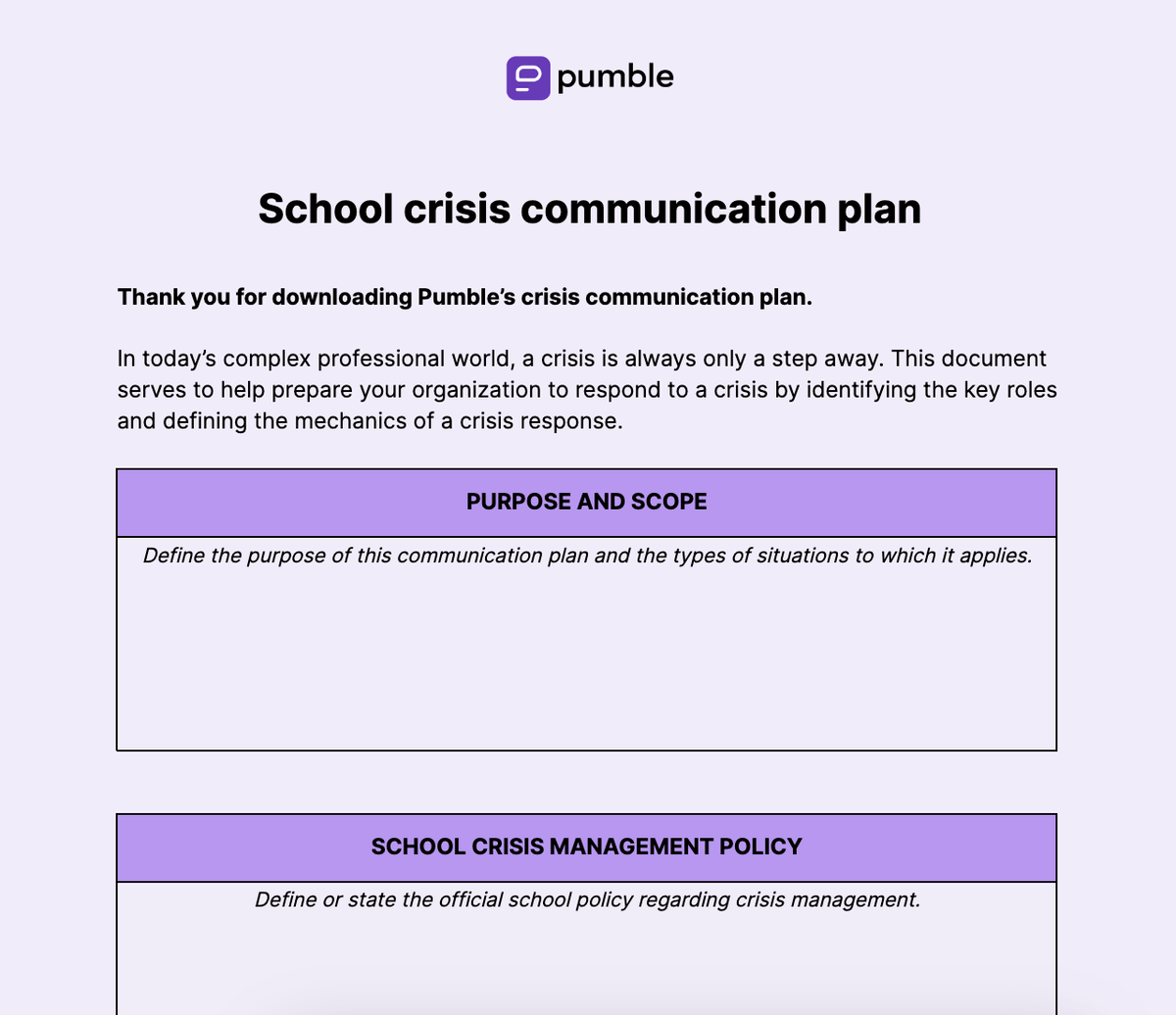
🔽 Download the School crisis communication plan template
University crisis communication plan template
Stay on top of all common crisis scenarios in higher education with a university-focused crisis communication plan template.

🔽 Download the University crisis communication plan template
Business crisis communication plan template
The volatile world of business is never too far removed from the next crisis. Prepare for what’s to come with this template specifically designed for the business ecosystem.
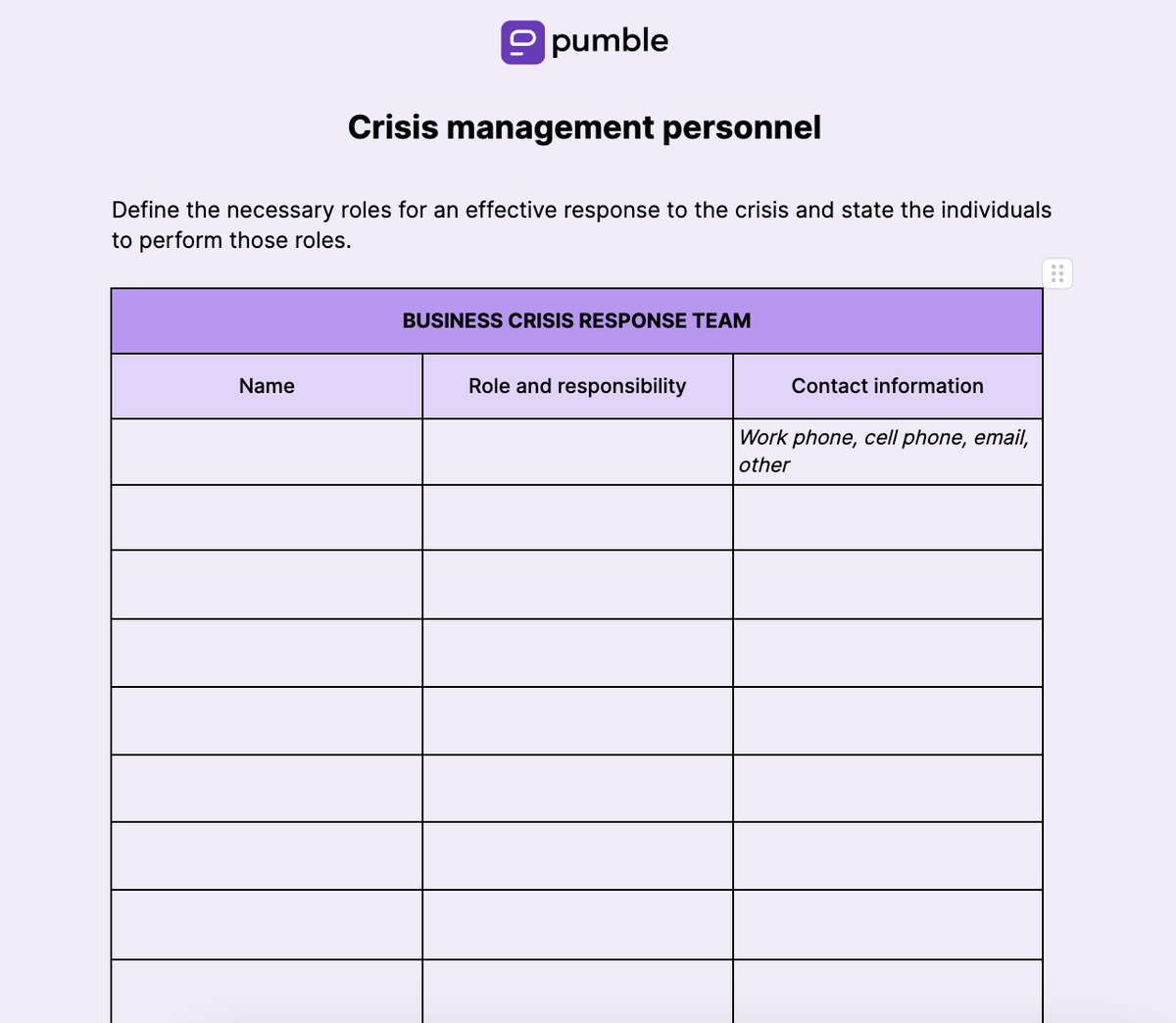
🔽 Download the Business crisis communication plan template
Technology crisis communication plan template
The increasingly complex world of technology is susceptible to all sorts of disruptions. Stay ahead of the game by planning and preparing for the next inevitable crisis.
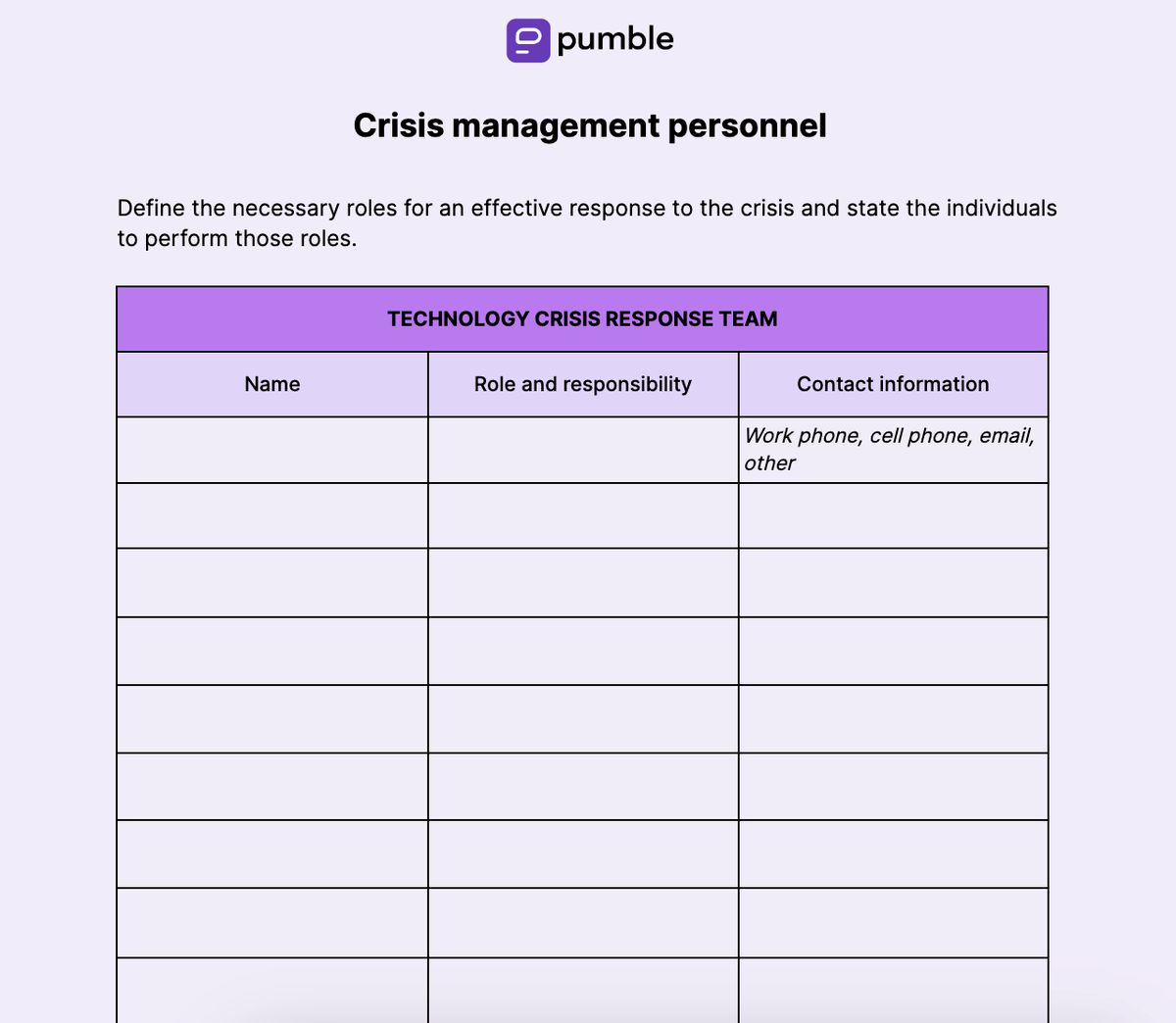
🔽 Download the Technology crisis communication plan template
Hospitality industry crisis communication plan template
From dissatisfied customers to disease outbreaks, the hospitality industry is fertile ground for a variety of crises. Sort out your communication ahead of the next one.
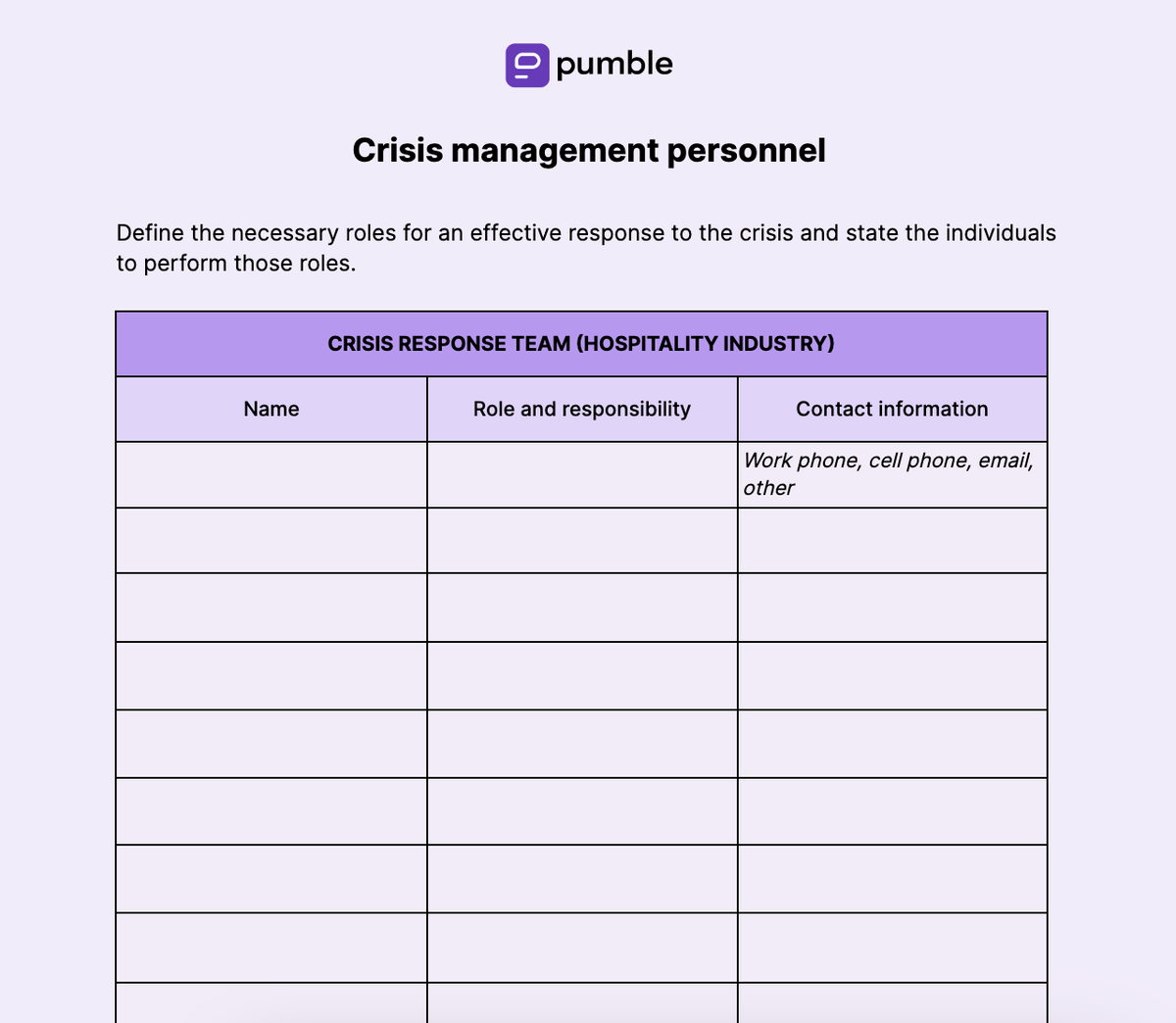
🔽 Download the Hospitality industry crisis communication plan template
Non-profit crisis communication plan template
The non-profit sector has seen its share of crises and disruptions, requiring organizations to plan for future turbulence. Stay vigilant and prepared for any eventuality.
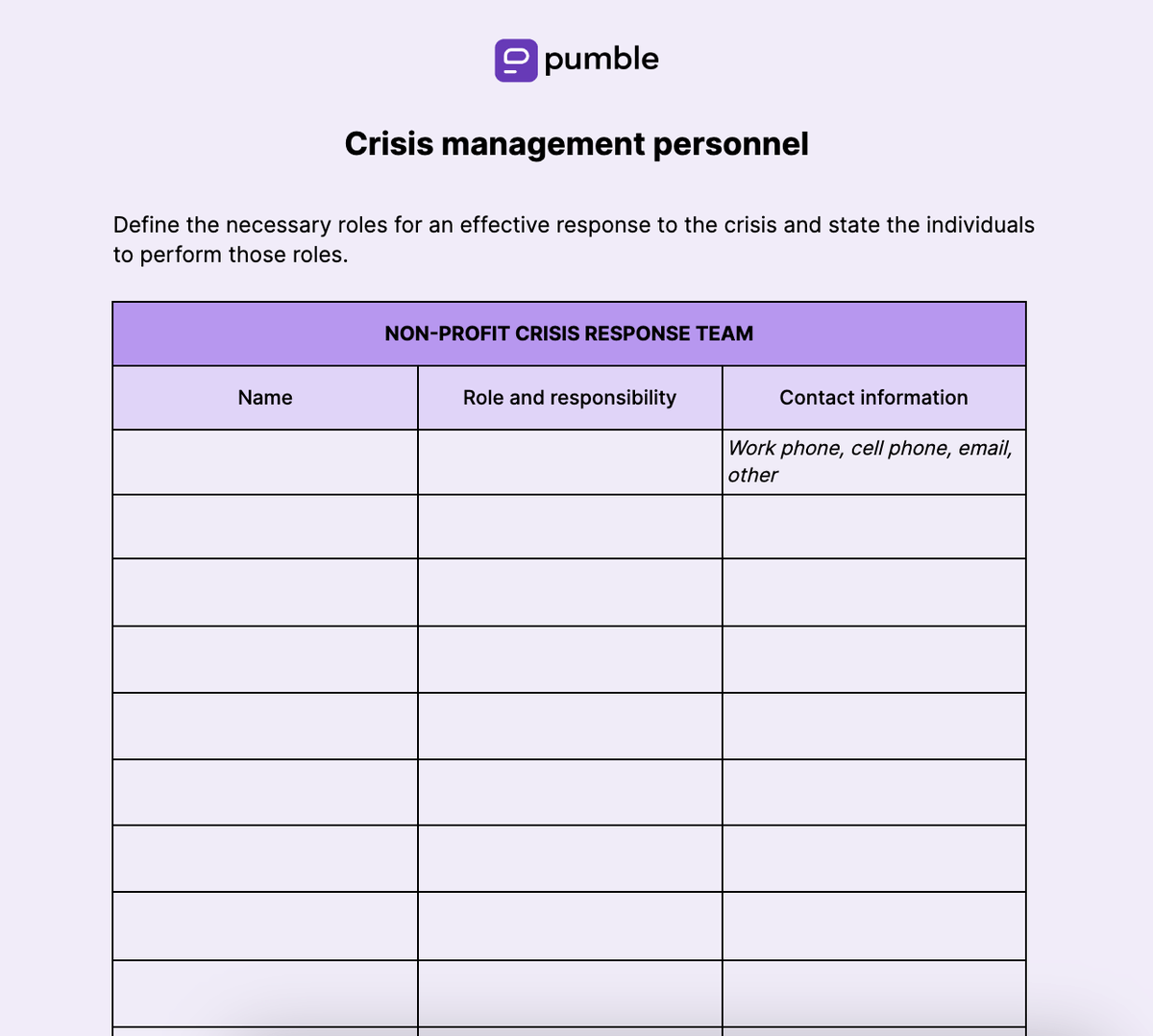
🔽 Download the Non-profit crisis communication plan template
Hospital crisis communication plan template
In healthcare, crises are quite common. Prepare to drive and shape the conversation to navigate the slippery slopes of crisis communication.
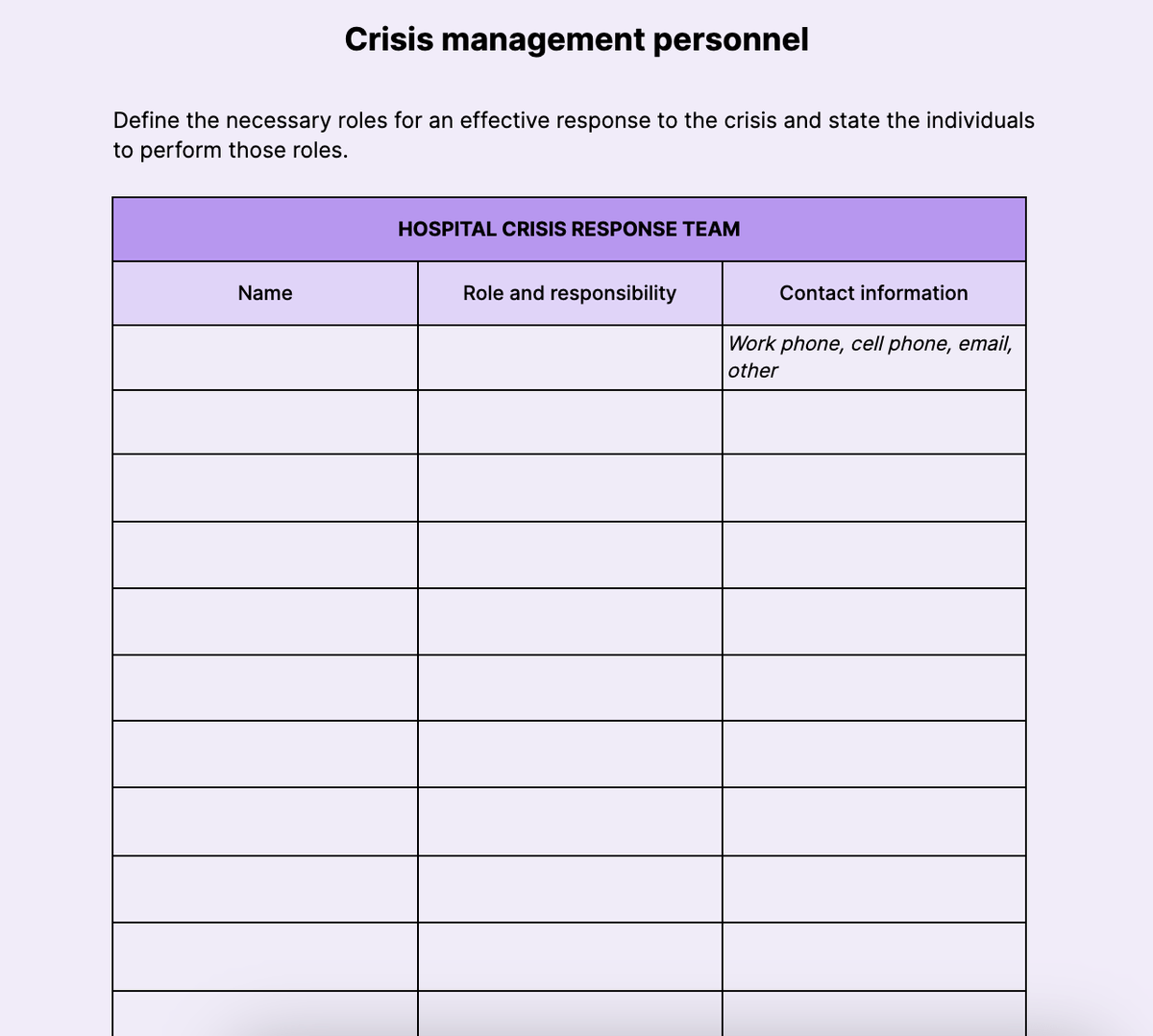
🔽 Download the Hospital crisis communication plan template
Sports crisis communication plan template
Egos, entitlement, disgruntled fans, financial “creativity” — the world of sports is a constant crisis in the making. Grab hold of any crisis situation by communicating proactively.
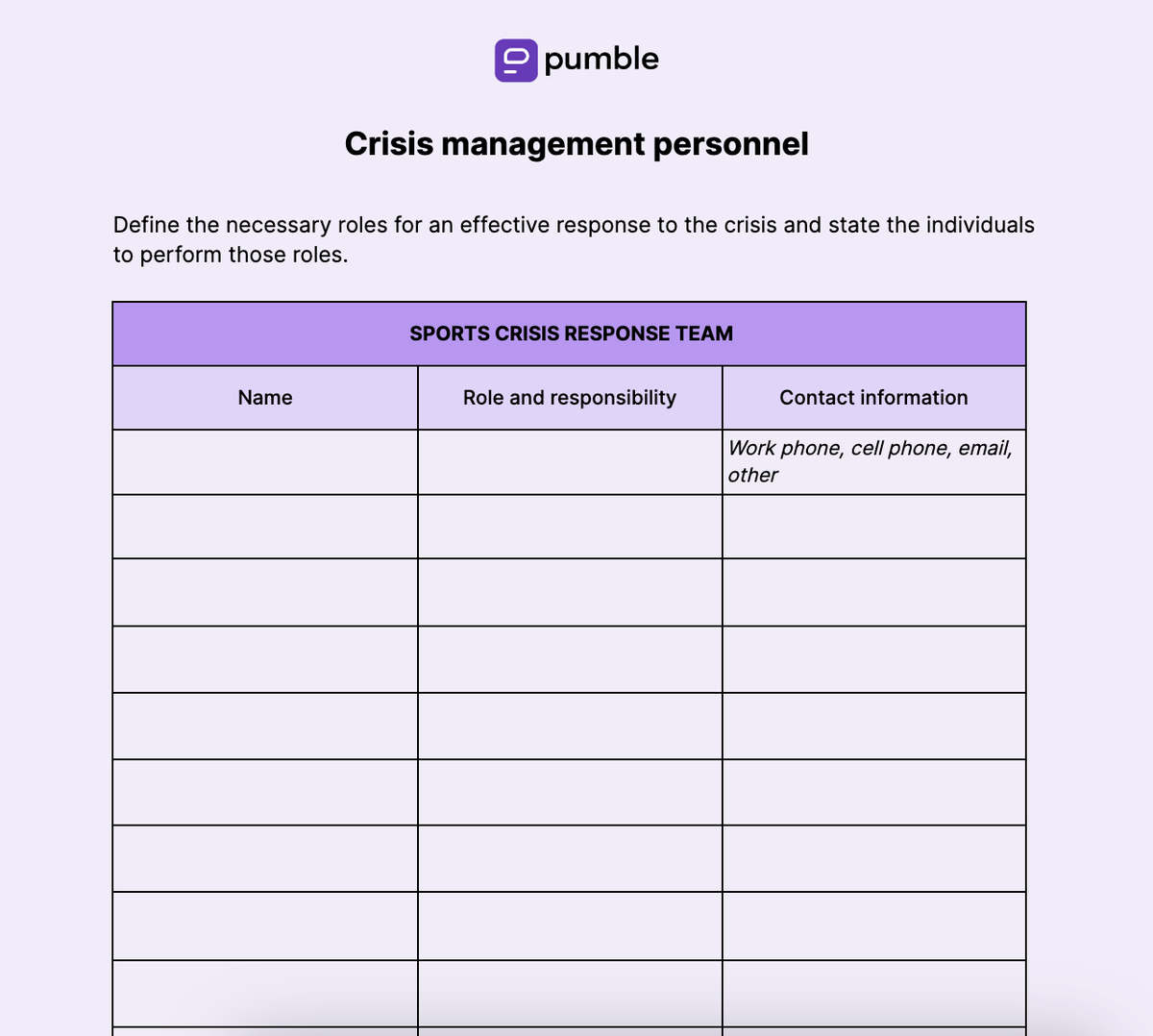
🔽 Download the Sports crisis communication plan template
Transport & logistics crisis communication plan template
Transport & logistics are a complex web of interconnected moving parts. Derail one part and you easily derail the whole. The next crisis is right around the corner — be prepared to respond!
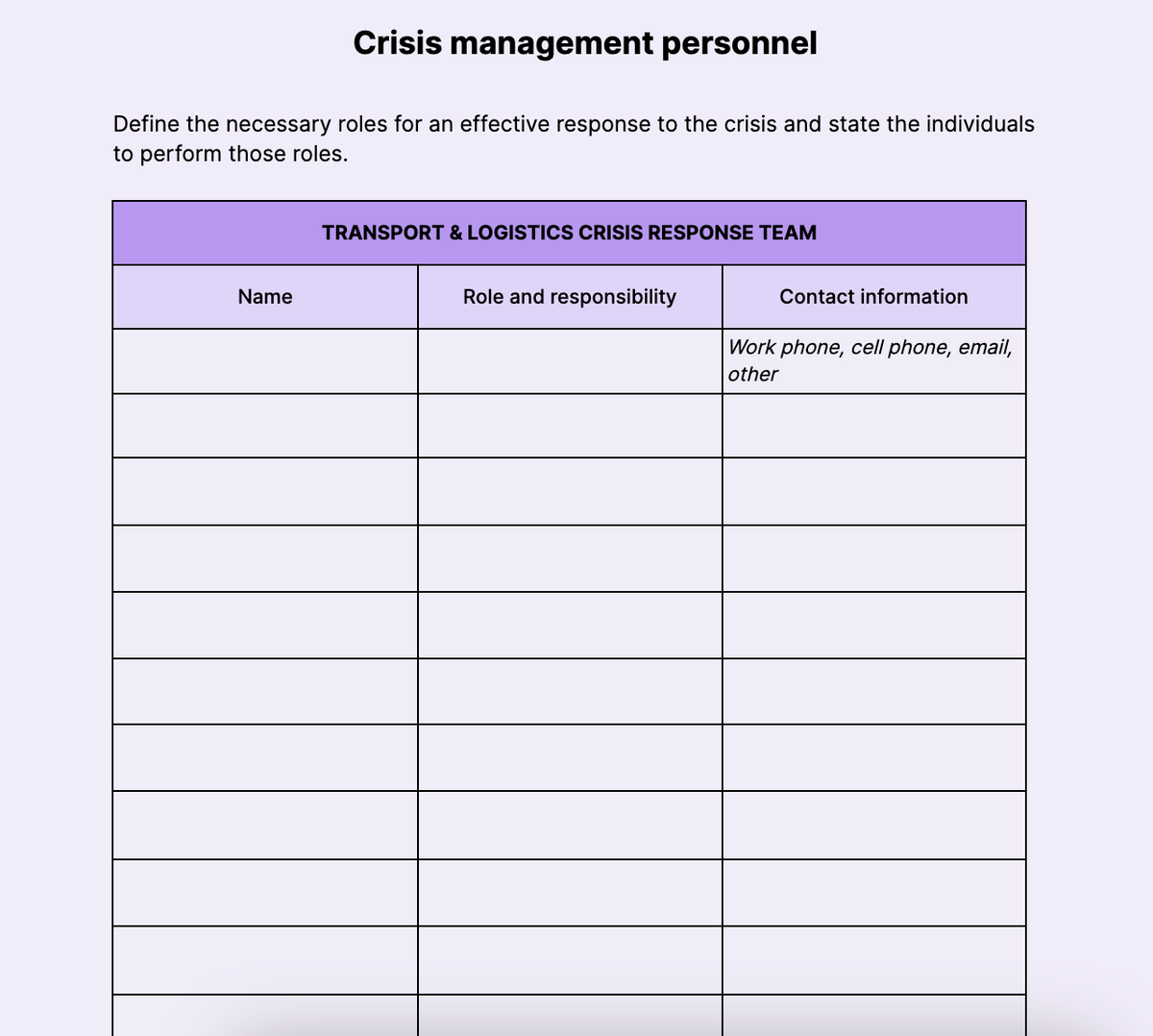
🔽 Download the Transport & Logistics crisis communication plan template
Agriculture crisis communication plan template
Food, air, and water are the building blocks of human life. That’s why every disruption in the agriculture industry can quickly become a full-blown crisis. Enable your organization to manage the surrounding conversation to your advantage.
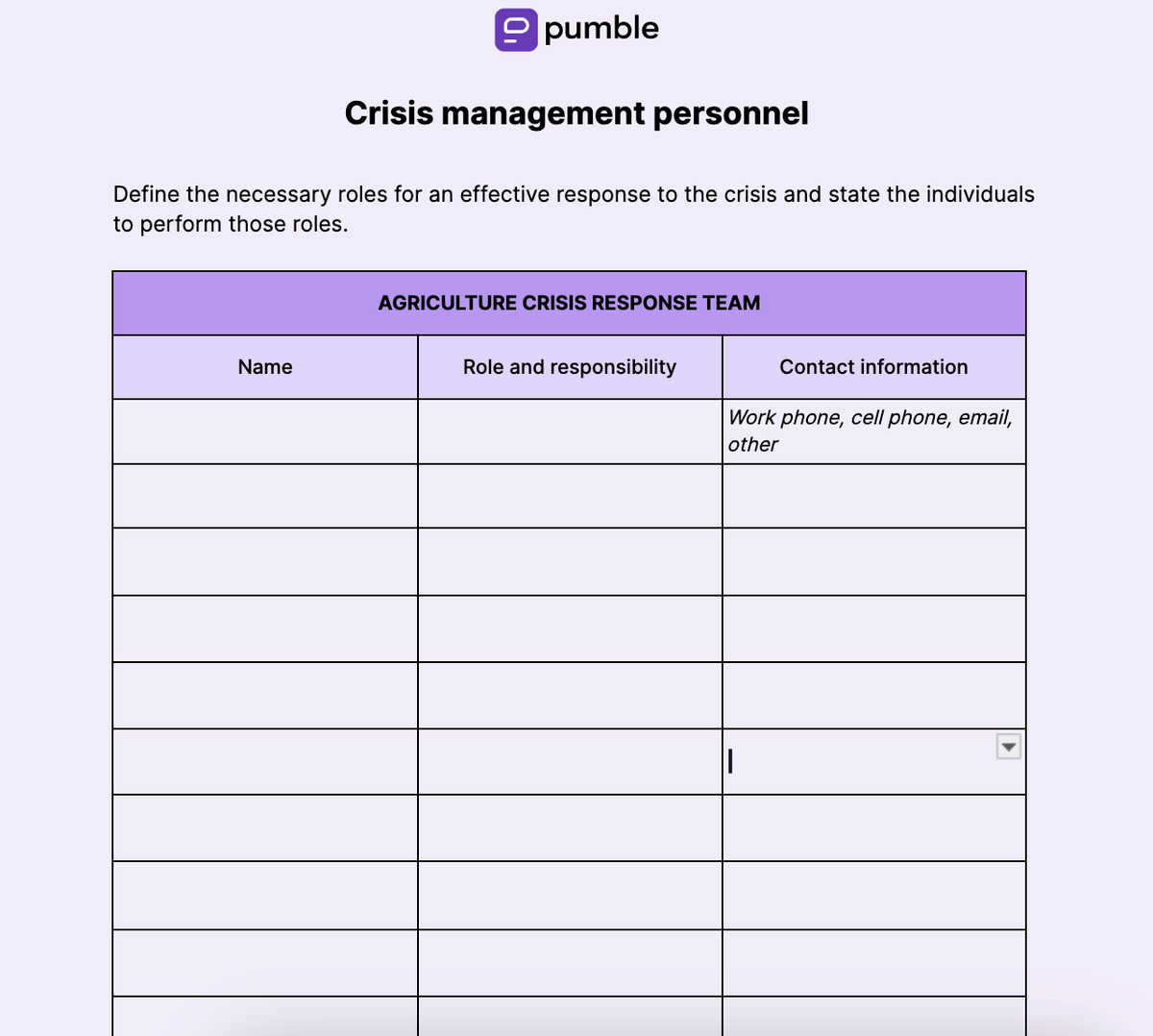
🔽 Download the Agriculture crisis communication plan template
Stay one step ahead of the unexpected with Pumble
As we’ve mentioned above, having organized alert mechanisms for the most important parties involved is the quickest way to stay ahead and act swiftly in crisis communication situations.
The easiest way to do this is to have your team at the ready — used to organized communication on a team communication platform like Pumble by CAKE.com.
Pumble is a digital HQ that allows teams to:
- Create channels. Organize your conversations according to topics, give access to important personnel or your entire team, and quickly instruct relevant members and subteams in times of crisis.
- Reply in threads. Streamline conversations with threads and allow for easier and quicker message navigation.
- Invite guests. Include external stakeholders in dedicated channels to keep them informed or get their input during a crisis.
- Customize notifications. Stay focused on the most important tasks during challenging moments.
- Share files and search easily. Navigate important information, documents, and data efficiently, with unlimited message history.
Alleviate tension, simplify your crisis response efforts, and stay sharp with a secure and reliable internal communication hub.
How we reviewed this post: Our writers & editors monitor the posts and update them when new information becomes available, to keep them fresh and relevant.


